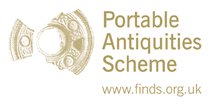Server check!
You are on the training database
Portable Antiquities Annual Report 2011
We are pleased to introduce this report on the work of the Portable Antiquities Scheme (PAS) and Treasure Act 1996, which also highlights some fascinating and important finds reported in 2011. We are especially grateful to Treasure Hunting who once again agreed to publish this report free within their magazine.
The PAS and Treasure Act continue to be a great success, highlighted by the fact that ITV have made a primetime television series - Britain's Secret Treasures - about the top 50 finds found by the public. It is thanks to the efforts of the finders and to the work of the PAS, particularly its network of Finds Liaison Officers, that 97,509 PAS and 970 Treasure finds were reported in 2011. This recording work was supported by interns, volunteers and finders who record their own discoveries, and we are particularly grateful to the Headley Trust and the Institute for Archaeologists/Heritage Lottery Fund who funded interns in the period of this report. We are therefore delighted that the Headley Trust has agreed to extend its funding for interns for a further two years, 2012/13 and 2013/14. We are also grateful to the generosity of an American philanthropist who has funded the post of assistant to the Finds Adviser for Iron Age and Roman coins, for two years.
Archaeological finds discovered by the public are helping to rewrite the archaeology and history of our past, and therefore it is excellent news that the Leverhulme Trust has agreed to fund a £150k project, 'The PAS database as a tool for archaeological research', to examine in detail the factors that underlie this large and rapidly growing dataset. Indeed, it is a testament to the PAS that this data is now being used by academics and researchers to advance archaeological knowledge, as well as by members of the public interested in learning more about the archaeology of where they live. Importantly, there are a number of instances this year when finders have stopped digging when
they have discovered something important (as in the case of the Vale of Wardour Hoard) so that the find can be recovered archaeologically, thus preserving important information about how and why such hoards were deposited.
The Treasure Act continues to ensure that the most important archaeological objects are acquired by museums so they can be enjoyed by all. The Government will shortly begin a review of the Treasure Act Code of Practice, to ensure that the guidance contained in the Code is up-to-date and useful.
External funding has contributed enormously to the ability of museums to acquire Treasure finds, and therefore we are particularly grateful to the Art Fund, the Headley Trust, the Heritage Lottery Fund, the National Heritage Memorial Fund and the V&A Purchase Grant Fund, as well as various individuals. We should also like to thank those finders and landowners who have generously waived their right to a reward, allowing museums to acquire such finds at reduced or no cost. Finally we would like to thank the members of the Portable Antiquities Advisory Group, who have provided the PAS with important guidance, and the Treasure Valuation Committee members, who have provided expert advice to the Secretary of State.
Neil MacGregor (Director of the British Museum) and Ed Vaizey (Minister for Culture, Communications & Creative Industries)
Key points
- 97,509 finds were recorded by the PAS; a total of 810,000 finds recorded on the PAS database (finds.org.uk/database) to date.
- 970 Treasure cases were reported; it is hoped that many of these will be acquired by museums for public benefit.
- 78 parties waived their right to a reward in 40 Treasure cases, allowing them to be acquired by museums at no or reduced cost. Most PAS finds are returned to the finder.
- 86% of PAS finds and 92% of Treasure finds were found by metal-detectorists.
- 83% of PAS finds were found on cultivated land, where they are susceptible to plough damage and artificial and natural corrosion processes.
- 91% of PAS finds were recorded to the nearest 100m2, the minimum requirement for findspot information for Historic Environment Records.
- New sites discovered through finds recorded by the PAS include a Roman villa on the Isle of Wight, Anglo-Saxon cemeteries in Leicestershire and North Lincolnshire and a post-medieval pottery kiln in Somerset.
- Currently 261 people have full access to PAS data for research purposes, and there are a further 3,940 registered users. To date, PAS data has been used in 313 research projects, including 12 pieces of large-scale research and 62 PhDs.
- 463,160 unique visitors visited the PAS websites, making over 677,965 visits and 4,485,956 page requests.
- Publications associated with the work of the PAS include reports in Britannia, Medieval Archaeology and Post-Medieval Archaeology.
- 881 outreach events took place, including talks, finds days and exhibitions. These were attended by at least 39,996 people, including 6,614 children.
- The Scheme's Finds Liaison Officers had regular contact with 199 metal-detecting clubs, attending 927 club meetings.


